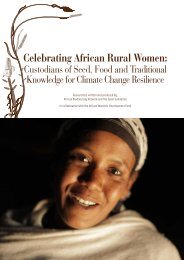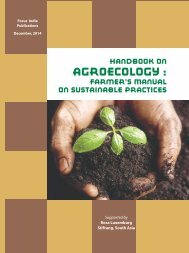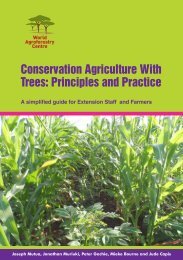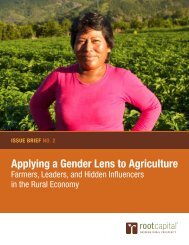1t0SC7l
1t0SC7l
1t0SC7l
You also want an ePaper? Increase the reach of your titles
YUMPU automatically turns print PDFs into web optimized ePapers that Google loves.
Tropenbos-Cameroon Programme, the logging company Wijma-Douala SARL (GWZ) and<br />
ORSTOM researchers. Such clarification of roles at early stage of intervention of the research<br />
team was necessary and indispensable to avoid any misunderstanding that might jeopardise the<br />
future collaboration between the farmers and the team. During group interviews, the ‘focus<br />
group’ approach was used to obtain information on each item of the checklist. The group<br />
interview always ended with few minutes of conversation (‘conversational interview’) during<br />
which notebooks were closed, the atmosphere more relaxed, and farmers feeling free, confident,<br />
and more open to speak frankly. It was at this stage of the interview that information could be<br />
obtained on sensitive issues.<br />
Field visits followed the group interview. Three or more fields were visited to observe, confirm<br />
and cross check some of the contradictory information obtained during the group interview.<br />
2.2.4 Measurement of the size, crop density and yield of agricultural fields<br />
Size<br />
In the four sub-sites described in Section 2.1.1, collaborative farmers from 35 households were<br />
randomly selected. The size of all fields opened from 1995 to 1997 (290 fields in total) were<br />
measured, mapped and their geographic co-ordinates recorded using compass, GPS (Global<br />
Positioning System), measuring tape and GIS (Geographical Information System). The method<br />
consisted of subdividing the perimeter of the field to be sized into rectilinear segments and<br />
recording for each segment its length in meters using measuring tape and its direction in degree<br />
(or grade) using compass. The geographic co-ordinate of the field was recorded using the GPS.<br />
In the office, the reconstruction of these directions and lengths on a graph paper re-built the<br />
shape of the field. The drawing obtained on paper was then digitised in GIS equipment and the<br />
computer provided the surface area of the polygon. The surface area of many fields measured<br />
could thus be computed at once.<br />
Crop density and yield<br />
In each mixed crop field, 4 to 5 squares of 4m x 4m were established for crop density and crop<br />
yield measurements. In each square, crop plants were counted for crop density determination.<br />
The density of each crop in the field was estimated as the average of all squares. During<br />
harvesting, all harvested crops from these squares were weighed. Sub-samples for estimation of<br />
biomass and grain yield dry weight of maize and groundnut were taken, oven-dried and<br />
weighed.<br />
2.2.5 Farmers’ priority setting<br />
The study was to identify farmers’ priority needs in time and space from an agricultural and<br />
socio-economic point of view. Twenty (20) villages of the TCP area were covered by a<br />
structured questionnaire interview. Ten (10) farmers were interviewed per village, taking into<br />
account age, sex, ethnic group (or tribe) and accessibility. A total of 200 interviews were<br />
conducted. Relative frequency was used for priority setting, that is, the scores were tallied by<br />
rank and the ranking 1 was given to the answer, which scored most often as priority 1, ranking 2<br />
was given to one the remaining answers, which scored most often as priority 2, etc.<br />
2.2.6 Farmers’ strategies for soil fertility management<br />
The study was to assess farmers’ way of coping with soil fertility problems in relation to<br />
agricultural production. Fifteen (15) villages in the TCP area were covered by a structured<br />
questionnaire interview. Five (5) farmers were interviewed per village. Farmers’ fallow<br />
strategies were assessed by measuring crop yields and by sampling and laboratory analysing<br />
soils from corresponding fallow plots nearby the crop fields. Data were tallied manually. Data<br />
were analysed using relative frequency and X 2 test. The rank was determined in the way<br />
described in Section 2.2.5, except that the sample size was 75.<br />
9








